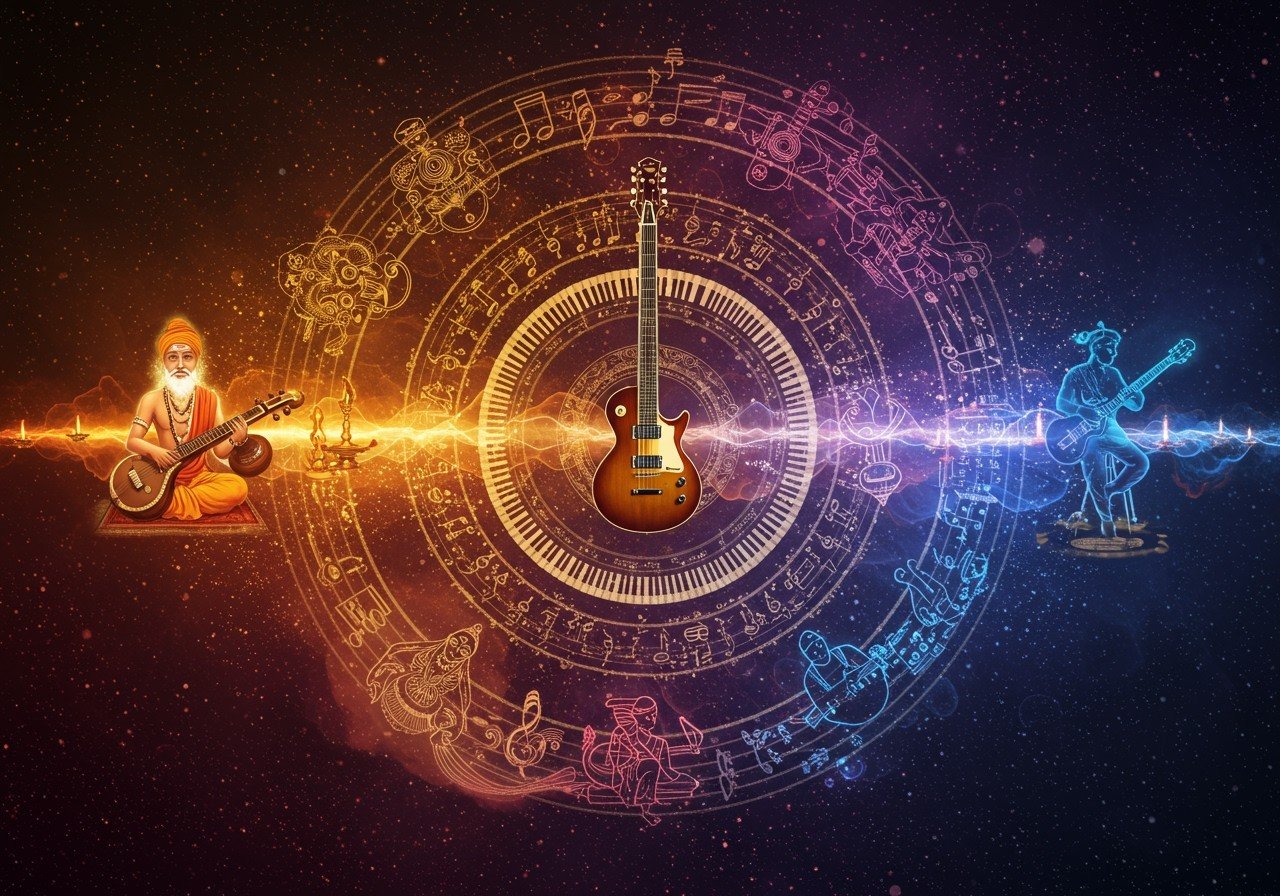
Indian music boasts a rich tapestry of sounds, rhythms, and melodies, woven over millennia. This vibrant art form has journeyed through ancient Vedic chants, flourished in the courts of emperors, and continues to evolve in the modern era. This exploration delves into the captivating history of Indian music, tracing its origins, celebrating its milestones, and acknowledging the diverse influences that have shaped its unique character. For a deeper understanding of Hinduism, explore our resources on Hinduism’s global reach and Hinduism’s origins.
Ancient Echoes: The Vedic Roots of Indian Music (1500-500 BCE)
The genesis of Indian music can be traced back to the Vedic period (circa 1500-500 BCE), where chants and hymns formed the bedrock of religious ceremonies. The Samaveda, one of the four Vedas, stands as a testament to the early integration of music into spiritual life, containing musical notations that guided the chanting of Vedic hymns. These sacred sounds laid the foundation for the complex melodic structures that would later characterize Indian classical music. The Rigveda, with its melodically recited hymns, further exemplifies the early development of musical structure in India. Here’s a glimpse into the key elements of this era:
- Nada Brahma (Sound as God): This profound concept, signifying the divine essence of sound, deeply influenced the development of early musical traditions. It established music not merely as an art form but as a pathway to spiritual understanding.
- Emergence of Instruments: The Vedic period witnessed the emergence of early musical instruments, including the veena (a stringed instrument) and the flute, demonstrating the growing sophistication of musical expression. These instruments became integral to both religious rituals and secular music.
- Natya Shastra (200 BCE – 200 CE): Authored by Bharata Muni, this ancient treatise codified the principles of music theory, dance, and drama. It laid down fundamental concepts of rhythm, melody, and musical forms, providing a framework for future generations of musicians and performers. It also explores the emotional impact of music and its power to evoke rasa (aesthetic flavor).
Medieval Melodies: The Rise of Classical Traditions (1200-1800 CE)
The medieval period witnessed the blossoming of classical music traditions, notably Hindustani music in the north and Carnatic music in the south. This era was marked by significant developments that enriched the Indian musical landscape:
- Influential Figures: Amir Khusro (1253-1325), a prominent poet and musician, is credited with the creation of numerous ragas (melodic frameworks) and the introduction of new musical instruments, significantly impacting both Hindustani and Carnatic music. His contributions bridged Persian and Indian musical traditions.
- Persian Influences: The Mughal era brought with it a wave of Persian musical influences, leading to the integration of new instruments, musical forms, and aesthetic sensibilities. This cross-cultural exchange enriched the existing Indian musical traditions, adding new layers of complexity and expression.
- Gharanas (Musical Schools): The establishment of gharanas, specialized musical schools, played a crucial role in preserving and transmitting classical music knowledge and traditions across generations. These schools became centers of musical learning and innovation.
Modern Harmonies: Fusion and Innovation (1800-Present)
The modern era has been a period of dynamic change and innovation in Indian music. Technological advancements, global interactions, and evolving cultural trends have all contributed to the reshaping of the musical landscape:
- British Influence and All India Radio: The British colonial period introduced Western musical elements, while All India Radio, established in 1936, played a pivotal role in popularizing both classical and folk music, broadcasting it to a wider audience. This exposure broadened the reach of Indian music and fostered a sense of national identity through shared musical experiences.
- Bollywood’s Impact: The rise of Bollywood cinema brought with it a unique fusion of traditional Indian music with contemporary styles, creating a genre that captured the imagination of millions. Bollywood music became a powerful force in popular culture, blending classical melodies with Western instrumentation and modern rhythms.
- Musical Icons: Legendary figures like Ravi Shankar (1920-2012), a world-renowned sitar maestro, and Lata Mangeshkar (1929-2022), the “Nightingale of India,” made indelible contributions to Indian music, gaining international recognition and bridging cultural divides. Their artistry elevated Indian music to a global stage. For those inspired by Krishna’s divine music, explore our collection of Ladoo Gopal statues and learn more about Krishna’s flute. You can even create your own Krishna altar at home.
FAQs: Exploring the Evolution of Indian Music
What distinguishes Carnatic and Hindustani music?
While both are classical traditions, Carnatic music, predominantly from South India, emphasizes improvisation within a structured framework. Hindustani music, prevalent in North India, features a more elaborate system of ragas and allows for greater melodic exploration.
How has technology impacted Indian music?
Technology has revolutionized music production, distribution, and accessibility. Digital platforms empower independent artists, while recording technology allows for wider dissemination and preservation of musical traditions.
What is the role of music festivals in promoting Indian music?
Music festivals provide platforms for both established and emerging artists to showcase their talent, fostering appreciation and promoting Indian music to wider audiences, both nationally and internationally.
Poojn.in: Your Spiritual Companion
Poojn.in offers a curated selection of incense sticks and other puja essentials to enhance your spiritual practices. Whether you seek traditional instruments, devotional music, or items for creating a sacred space, Poojn.in is your trusted source. Discover the perfect accompaniment to your spiritual journey with our range of high-quality products.


